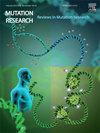Analysis of TERT promoter hotspot mutations using droplet digital PCR in hepatoblastoma and hepatocellular carcinoma
IF 1.9
4区 医学
Q4 BIOTECHNOLOGY & APPLIED MICROBIOLOGY
Mutation Research-Fundamental and Molecular Mechanisms of Mutagenesis
Pub Date : 2025-07-01
DOI:10.1016/j.mrfmmm.2025.111915
引用次数: 0
Abstract
Somatic mutations in the telomerase reverse transcriptase promoter (TERTp) region are common in many cancers, including in liver cancers. Detection of TERTp mutations in tumor tissue DNAs and cell-free tumor DNAs is useful for diagnosing and monitoring cancers. Since the most common TERTp hotspot mutations, C228T and C250T, are difficult to identify using Sanger sequencing, we tested an easy and highly sensitive alternative method that targets these two sites using droplet digital PCR. Using this method, both the sensitivity and specificity for detecting these two mutations were 100 % in DNA samples derived from cell lines and liver cancer tissues, including hepatocellular carcinoma (HCC) and hepatoblastoma (HB). The detection limit for the allele frequencies of these mutations was approximately 0.1 %. This method is also widely applicable; for instance, it can be applied to DNA derived from FFPE (formalin-fixed paraffin embedded) samples. In addition, we applied this method to detecting TERTp mutations in cell-free DNA samples of patients with TERTp-mutated tumors. Finally, we found that outcomes for HB patients with TERTp mutations were significantly worse than in those without mutations, indicating the importance of this method for improving patient outcomes. In light of this, we discuss the advantages of this method for clinical implementation in the detection and monitoring of cancers.
肝母细胞瘤和肝细胞癌中TERT启动子热点突变的微滴数字PCR分析
端粒酶逆转录酶启动子(TERTp)区域的体细胞突变在许多癌症中都很常见,包括肝癌。检测肿瘤组织dna和无细胞肿瘤dna中的TERTp突变对癌症的诊断和监测是有用的。由于最常见的TERTp热点突变C228T和C250T难以用Sanger测序识别,我们测试了一种简单且高灵敏度的替代方法,使用液滴数字PCR靶向这两个位点。使用该方法,在细胞系和肝癌组织(包括肝细胞癌(HCC)和肝母细胞瘤(HB))的DNA样本中检测这两种突变的灵敏度和特异性均为100 %。这些突变的等位基因频率检测限约为0.1 %。这种方法也广泛适用;例如,它可以应用于来自FFPE(福尔马林固定石蜡包埋)样品的DNA。此外,我们将该方法应用于TERTp突变肿瘤患者的无细胞DNA样本中TERTp突变的检测。最后,我们发现TERTp突变的HB患者的预后明显差于无突变的HB患者,表明该方法对改善患者预后的重要性。鉴于此,我们讨论了该方法在癌症检测和监测中的临床实施优势。
本文章由计算机程序翻译,如有差异,请以英文原文为准。
求助全文
约1分钟内获得全文
求助全文
来源期刊
CiteScore
4.90
自引率
0.00%
发文量
24
审稿时长
51 days
期刊介绍:
Mutation Research (MR) provides a platform for publishing all aspects of DNA mutations and epimutations, from basic evolutionary aspects to translational applications in genetic and epigenetic diagnostics and therapy. Mutations are defined as all possible alterations in DNA sequence and sequence organization, from point mutations to genome structural variation, chromosomal aberrations and aneuploidy. Epimutations are defined as alterations in the epigenome, i.e., changes in DNA methylation, histone modification and small regulatory RNAs.
MR publishes articles in the following areas:
Of special interest are basic mechanisms through which DNA damage and mutations impact development and differentiation, stem cell biology and cell fate in general, including various forms of cell death and cellular senescence.
The study of genome instability in human molecular epidemiology and in relation to complex phenotypes, such as human disease, is considered a growing area of importance.
Mechanisms of (epi)mutation induction, for example, during DNA repair, replication or recombination; novel methods of (epi)mutation detection, with a focus on ultra-high-throughput sequencing.
Landscape of somatic mutations and epimutations in cancer and aging.
Role of de novo mutations in human disease and aging; mutations in population genomics.
Interactions between mutations and epimutations.
The role of epimutations in chromatin structure and function.
Mitochondrial DNA mutations and their consequences in terms of human disease and aging.
Novel ways to generate mutations and epimutations in cell lines and animal models.

 求助内容:
求助内容: 应助结果提醒方式:
应助结果提醒方式:


